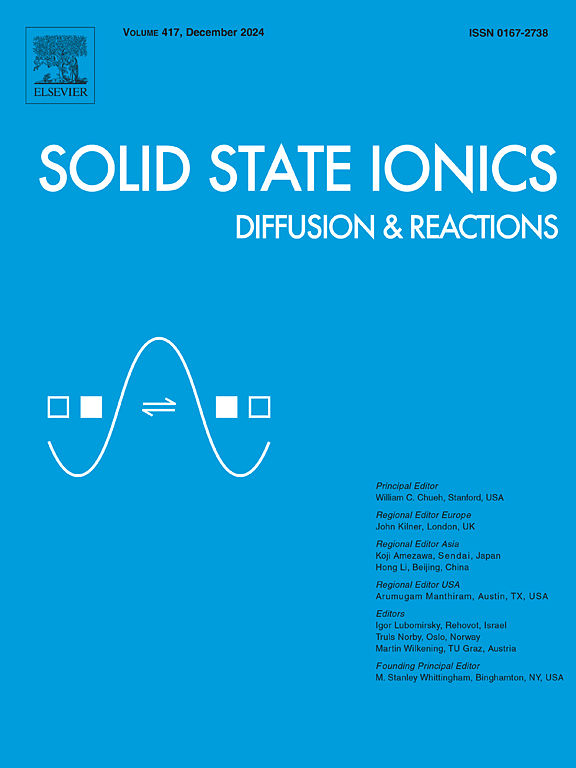Electronic and Li-ion diffusion properties in Fe0.875M0.125S2 (M = Ti, V)(001)|Li2S(110) interface by the first-principles study
IF 3.3
4区 材料科学
Q3 CHEMISTRY, PHYSICAL
引用次数: 0
Abstract
The structure and nature of the interface between the electrode and the discharge product have an important impact on the performance of Lithium‑sulfur (Li![]() S) batteries. We investigated the effects of transition metals Ti and V doped into FeS2 on the high-rate performance of the interface formed with Li2S(110). Using the first-principles calculations, we have investigated the interface between FeS2(001) with doping transition metal Ti and V, and Li2S(110). The investigation covered aspects such as lattice structure, electrochemical properties, diffusion of Li+ at the interface, distribution of charge, and work function. The results indicate that doping with transition metals Ti and V reduces the Li+ diffusion barrier. The interfacial density of states introduces metallic properties. Additionally, analysis of work function revealed that Ti doping promotes the establishment of an internal electric field in the interfacial structure which accelerates cycling and migration of Li+. This study enhances our understanding of interfacial structure and electrochemical properties between cathode host material and Li2S.
S) batteries. We investigated the effects of transition metals Ti and V doped into FeS2 on the high-rate performance of the interface formed with Li2S(110). Using the first-principles calculations, we have investigated the interface between FeS2(001) with doping transition metal Ti and V, and Li2S(110). The investigation covered aspects such as lattice structure, electrochemical properties, diffusion of Li+ at the interface, distribution of charge, and work function. The results indicate that doping with transition metals Ti and V reduces the Li+ diffusion barrier. The interfacial density of states introduces metallic properties. Additionally, analysis of work function revealed that Ti doping promotes the establishment of an internal electric field in the interfacial structure which accelerates cycling and migration of Li+. This study enhances our understanding of interfacial structure and electrochemical properties between cathode host material and Li2S.
用第一性原理研究Fe0.875M0.125S2 (M = Ti, V)(001)|Li2S(110)界面中电子和锂离子的扩散特性
电极与放电产物界面的结构和性质对锂硫电池的性能有重要影响。我们研究了过渡金属Ti和V掺杂到FeS2中对与Li2S(110)形成的界面的高速率性能的影响。利用第一性原理计算,我们研究了掺杂过渡金属Ti和V的FeS2(001)与Li2S(110)之间的界面。研究内容包括晶格结构、电化学性能、界面上Li+的扩散、电荷分布和功函数。结果表明,过渡金属Ti和V的掺杂降低了Li+的扩散势垒。界面态密度引入了金属性能。此外,功函数分析表明,Ti的掺杂促进了界面结构内部电场的建立,加速了Li+的循环和迁移。本研究提高了我们对阴极主体材料与Li2S之间的界面结构和电化学性能的认识。
本文章由计算机程序翻译,如有差异,请以英文原文为准。
求助全文
约1分钟内获得全文
求助全文
来源期刊

Solid State Ionics
物理-物理:凝聚态物理
CiteScore
6.10
自引率
3.10%
发文量
152
审稿时长
58 days
期刊介绍:
This interdisciplinary journal is devoted to the physics, chemistry and materials science of diffusion, mass transport, and reactivity of solids. The major part of each issue is devoted to articles on:
(i) physics and chemistry of defects in solids;
(ii) reactions in and on solids, e.g. intercalation, corrosion, oxidation, sintering;
(iii) ion transport measurements, mechanisms and theory;
(iv) solid state electrochemistry;
(v) ionically-electronically mixed conducting solids.
Related technological applications are also included, provided their characteristics are interpreted in terms of the basic solid state properties.
Review papers and relevant symposium proceedings are welcome.
 求助内容:
求助内容: 应助结果提醒方式:
应助结果提醒方式:


